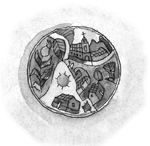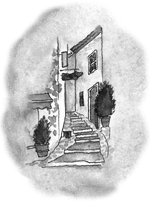The Way of Wanderlust (35 page)


Because I've been a travel writer and editor all my life, I like to think I have a pretty good grasp of the worldâwhich is why the assignment described in this story was especially confounding.
AFAR
magazine has a regular feature called Spin the Globe, where they dispatch a writer to a place with only twenty-four-hours' advance notice. In my case, I was told two weeks in advance that I would need certain immunizations, one of which was for malaria, so I ignorantly assumed that I was going somewhere in Africa. Twenty-four hours before my plane was to leave, I received the email announcing my destination: El Salvador. I'm supremely embarrassed now that my initial reaction was, “Where?” I knew nothing about El Salvadorâand that, of course, is precisely why travel is so wonderful. Once again, the classroom of the world had much to teach me, and not just about El Salvador, as I hope this story shows.
![]()
EL SALVADOR. THIS WAS EMBARRASSING.
Despite twenty-five years as a travel writer and editor, I was barely sure the country was in Central America. Yet in twenty-four hours I would be headed there on an impromptu magazine assignment. My ignorance, it turned out, was shared by all my supposedly worldly, well-traveled friends. None had any information for me.
Except one. “Don!” wrote an executive consultant who works in San Francisco. “That is my country! My sister still lives there. I will introduce you!”
So, on my first morning in El Salvador, I found myself sitting across from a kind-faced woman who told me, “Actually, I've put together about a dozen books on many aspects of El Salvadorâthe ruins, the nature preserves, the flora, the fauna.” We were in my hotel's open courtyard, looking onto a garden of green vines and red and yellow bloomsâunexpected fecundity and tranquility in the mostly grimy, clattering capital, San Salvador. My visitor swept an arm toward the green highlands and volcanic peaks far beyond. “I love my country, and I would be very happy to introduce you to its riches over the next few days.”
I soon learned that my breakfast companion, Claudia Allwood, not only had published books about El Salvador but also had been the first secretary of culture after the civil war ended in 1992, and later served in the Ministry of Foreign Affairs for years. In other words, by sheer serendipity I had gained one of the most knowledgeable people in all of El Salvador as my Spin the Globe guide. For the next two days, Claudia led me deep into the countryside and culture of her homeland. On that first afternoon, she drove me south to the port of La Libertad, where we walked past stalls selling lobsters, crabs, and a dozen varieties of flopping fish.
Later, as we gazed over a sweepingâand noticeably tourist-freeâsandy beach near El Sunzal, Claudia sighed, “One thing you must know is that our recent history has been very difficult. In the 1930s, the government massacred the indigenous people. In the 1970s and '80s, the rebels and the right-wing government forces waged a devastating civil war. These were very dark times, and virtually every family in El Salvador was affected in some way. But now,” she continued, her face softening as a smile broke through, “we are looking ahead. We are determined to make the future better than the past.”
The legacy of that brutal war underlay every encounter during my weeklong stay. It cropped up in my conversations with Carolina Baiza, the environmental projects manager of Ãrbol de Fuego, the wonderful eco-hotel where I stayed in San Salvador. Almost everyone in her hometown, located in the worst of the war zones, had fled or gone into hiding during the war, she told me.
“My grandmother was one of the few people who kept their businesses open,” Carolina said with a rueful shake of her head. “She had a general store, and she was a master of discretion. One week she would sell to the leftists; the next week she would sell to the partisans of the right. Her business was booming! But even for her, those years were awful.”
I met a taxi driver who had lost a brother, a shopkeeper who had lost a son, a waitress whose brothers had fled abroad. On a visit to Suchitoto, a colonial town of about 25,000 people, an hour's drive north of the capital, it all became real to me in a new and personal way. A one-room exhibition in the Centro Arte para la Paz showed an enlarged photograph of a dozen teenage boys standing in a semicircle and grinning widely. Immediately I thought of my son's high school soccer team, who had struck just such a pose, all excitement and hope, before a championship gameâexcept instead of soccer balls, these boys were holding automatic rifles.
And yet, despite the heartbreak and horror of that periodâwhich ended with the signing of a peace treaty in 1992âbrilliant smiles greeted me virtually everywhere I went. From hotel clerks
and office workers to backcountry cooks and wizened weavers to the everyday entrepreneurs who walked the streets selling fresh-plucked papayas in woven baskets and handfuls of cashews in neatly tied bags, everyone I met exuded resiliency, determination, and hospitality. In every interaction, there was visible pride in El Salvador today and a resolve to show the country in its best light.
Embodying this effort, Claudiaâwho seemed to know every person of importance (“I'm so sorry the minister of tourism is away,” she said at one point, “I would have loved for you to meet him.”)âhad arranged for me to meet with Fernando Llort, an artist revered throughout the land for his simple, buoyant paintings of rural scenes and for the gift of art and hope he has given to his fellow Salvadorans. On my third morning, we met in the living room of Fernando's humble one-story home in San Salvador. It was just around the corner from his two-room museum, where I had immediately fallen in love with his primary-color, Picassoesque renditions of animals, birds, flowers, women balancing baskets on their heads, and white adobe houses with terra-cotta tiled roofs.
“I get my images from the Savior,” Fernando said, “and I think I am his instrument to bring hope and joy, inspiration and healing to the people.”
As part of this healing, Fernando created a series of workshops to teach the residents of his wife's hometown, La Palma, how to paint in his vivid, childlike style, and also how to create intricate colored carvings in wood and on seeds of a legume called
copinol
. Those same workshops now employ hundreds of artisans who turn out folk-art bowls, plates, tiles, and, yes, refrigerator magnets. From the craftspeople who make the art to the shopkeepers who sell it and the restaurateurs and hoteliers who serve the tourists who come to see it, Fernando has sparked an entire town's economic revitalization.
That's one tile in the mosaic of modern El Salvador. I discovered another that evening in Suchitoto, when I joined the weekly Friday procession of the Stations of the Cross. Some 350 townspeople, ranging in age from elementary school kids to bent-over elders, gathered in the cobbled streets of the town center.
A half-dozen boys in medieval cassocks, one swinging a smoking censer, others holding flaming torches, led the procession. Four sturdy young men carried a wooden figure of Christ bearing the cross. Drawings depicting the stations were hung on different street corners, and the faithful shuffled slowly from one illustration to the next, chanting as they walked. When they reached each station, they stopped, and a nun or priest read the relevant verses from scripture. Then all intoned the Lord's Prayer.
As we walked in the torchlight through the darkened streets, I felt like I was moving back through centuriesâuntil I noticed some bored teenagers surreptitiously checking their cell phones. Still, the sweep and resonance of the past carried us into the cathedral, where the ceremony swashed into an incantatory sea of prayer.
After the procession, I stopped for a Pilsener beer at the only bar still open on the town square and joined three U.S. visitors, who were volunteering locally, and one of their Salvadoran friends. The volunteers' idealism was inspiring, but what stayed with me was the very end of our conversation, when I asked the Salvadoran what his dreams were for his life. After a pause, he spoke haltingly: “I want to have a wife. I want to have a family. I want to give my children an education. I want to have a stable income. I want to have a home.” He stopped. That was all. Suddenly the night was suffused with gratitude and hope and despair and pain and wonder. Five bottles clinked; five voices rose in a single cheer: “El Salvador!”
As I walked through the silent streets to my hotel, the Salvadoran man's aspirations mingling in my mind with the timeless prayers of the torchlit parade, I remembered the night before in San Salvador, when Carolina had taken me for a ten-minute walk to her favorite pupuserÃa. As we approached the neighborhood square, we came upon a group of mostly twenty- and thirty-year-olds in shorts, T-shirts, and running shoes, stretching and jogging in place.
We watched, amazed, as more and more people, old and young, all dressed to run, joined the crowd. Carolina asked a passerby what was going on.
“Ah!” she said when she heard the response. “Of course! A couple of nights a week, people gather in the square and run together through the town. The police accompany them to make sure one lane of traffic is open for them to run.”
She paused for a second and then turned to me. “I love this!” she said, and her face glowed with a moon-bright light. “During the war years, people couldn't even go out at night. Now, look at this! This is the new El Salvador.”
![]()

I've been in love with France since my first visits in the 1970s. Something about the French language, culture, and approach to life connects on the deepest level with me. As the site of my first infatuation, Paris will always occupy the primary place in my heart, but the region that has enchanted the (slightly) more mature me is the C
ô
te d'Azur. When I explored Nice, Cagnes-sur-Mer, Villefranche-sur-Mer, and Saint-Paul-de-Vence in the mid-1990s, these seemed like heaven to meâand they still do. The climate, the landscape, the art, the sensual ease, the abundance of fresh fruit and vegetablesâthe light! The C
ô
te d'Azur embodies so many of the quintessential riches of life for me. And that's why my stay in Saint-Paul-de-Vence meant so much, because for a day I was able to indulge a deeply held dream, and make a home in that fabled place.
